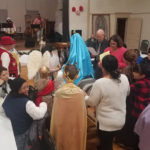
A man types on an Apple iPad in this file photo. Experts say mobile devices make accessing pornography easier.
The Hopeful Household: a series about “the real issues that families are facing and where to find hope in the messiness of life.”
By Anne Marie Amacher
The Catholic Messenger
Deacon Chris Kabat got into the ministry of pornography education and prevention by accident. A member of St. Wenceslaus Parish in Iowa City, he was completing his coursework for a Master of Pastoral Theology degree.
“I wrote my final integration paper before graduation in May of 2017 on the beauty of marriage and how it is distorted by pornography. This opened the door to learning more than I ever knew and it started a journey of continuing discovery to where I am today — assisting those struggling to overcome, providing education and prevention of this happening to our families. I never dreamed I would be doing something like this, but sometimes God has a way of nudging you along and before you know it you are all in to try and proclaim the Good News.”
Through this ministry, he has been able to help people addicted to pornography to truly encounter Jesus. “It is a beautiful experience to see that connection take place in someone,” said Deacon Kabat, a member of the diocesan Marriage and Family Committee.
He presently is working with Jason (not his real name), 28, through Sexaholics Anonymous (SA). Jason agreed to share his story with The Catholic Messenger. At age 12, Jason was first exposed to pornography on television and the internet. He viewed it on late-night television and the internet whenever it was unmonitored.
Deacon Kabat said most people are first exposed to pornography between ages 8-9 years old. Whether these youths get addicted early on depends on how quickly a person they trust intervenes. “A parent or teacher that can re-establish relationship with them and help them unpack that what they saw is not real. If it goes unchecked, it can certainly lead to addiction cycles and get harder and harder to break away from.”
“I was hooked right away and the addiction got worse,” Jason said. “Anytime I could, I would access it.” He viewed pornography multiple times a week for several hours. “It was almost always internet videos, although it got more personal and more risky as the addiction grew,” Jason said.
A multibillion-dollar industry, pornography comes in many different forms — pictures in print and online, videos and even graphic novels. “Anything that puts our God-given sexuality at risk of being something it was not intended to be it is likely pornography. If you get that internal feeling of excitement, arousal or just a ‘funny-feeling’ from it — then it is pornography,” Deacon Kabat said.
Pornography can satisfy a “pleasure center” and the chemical reaction in the brain is similar to that of a hit of heroin, Deacon Kabat said. “If one feels alone, ashamed or isolated — pornography fills the void. If they have been ‘sexualized’ at an early age this can distort the feeling of connection and they search out ways to subdue the pain. And once that brain stimulation starts to happen there is an escalation factor that draws you back and draws you to more and more extreme versions of it to get the same ‘high.’”
Deacon Kabat said there has been a big increase in the “rape culture” driven by pornography consumption. “People think that once they see it their partner or any random partner they ‘hook up’ with ought to be able to reproduce it for them and when they don’t, this leads to violence. People lose their jobs, money, marriages because of this.”
Some signs of addiction can include irritability, a pulling away from relationships, depression or agitation. “There is a general darkness about (the addicted individual) that unless you are tuned in you may not see. If one gets into conversation about it, the statement of ‘I just want this to go away!’ will emerge. If that happens it is likely that there is an addiction cycle going on.” Once pornography becomes an addiction, it can take three to five years to re-train healthy habits, Deacon Kabat said.
What can be done to break the cycle?
• Use filtering and accountability software such as Covenant Eyes.
• Get spiritual direction and/or counseling.
• Participate in 12-step groups such as SA (sexaholics anonymous).
• Visit the Davenport Diocese’s website for resources: www.davenportdiocese.org/pornography-awareness.
Jason said has wanted to do something about his addiction to pornography, but finally reached a turning point when he was 27. “It started to become clearer how it was going to destroy everything I held dear if I did not find a way to get better. The realization that, unchecked, my addiction was going to lead me into a situation that would cost me my family.”
He said his wife did not know the extent of his addiction. He has told her everything and his parents know a little about his addiction. In March 2017 he decided to seek help and has worked with Deacon Kabat for eight months.
Total honesty is one of the steps taken to break the cycle: “Total honesty with my wife, Deacon Kabat and members of SA. It is hard to be honest with my wife and others, but when I am truly honest with my wife and others it is much easier to avoid the downfall,” Jason said.
“Porn Stats” by Covenant Eyes, in surveys by the Barna Group in the United States in 2014 and 2016 provide proof:
• Men who view pornography at least monthly: 18-30 years old, 79 percent; 31-49 years old, 67 percent; 50-68 years old, 49 percent.
• Men who view pornography several times a week: 18-30 years old, 63 percent; 31-49 years old, 38 percent; 50-68 years old, 25 percent.
• Women who view pornography at least monthly: 18-30 years old, 76 percent; 31-49 years old, 16 percent; 50-68 years old, 4 percent.
• Women who view pornography several times a week: 18-30 years old, 21 percent; and 31-49 years of age, 5 percent. For women ages 50-69 it was zero.
• 55 percent of married men say they watch porn at least once a month, compared with 70 percent of unmarried men.
• 25 percent of married women say they watch porn at least once a month, compared with 16 percent of unmarried women.

A man types on an Apple iPad in this file photo. Experts say mobile devices make accessing pornography easier.











